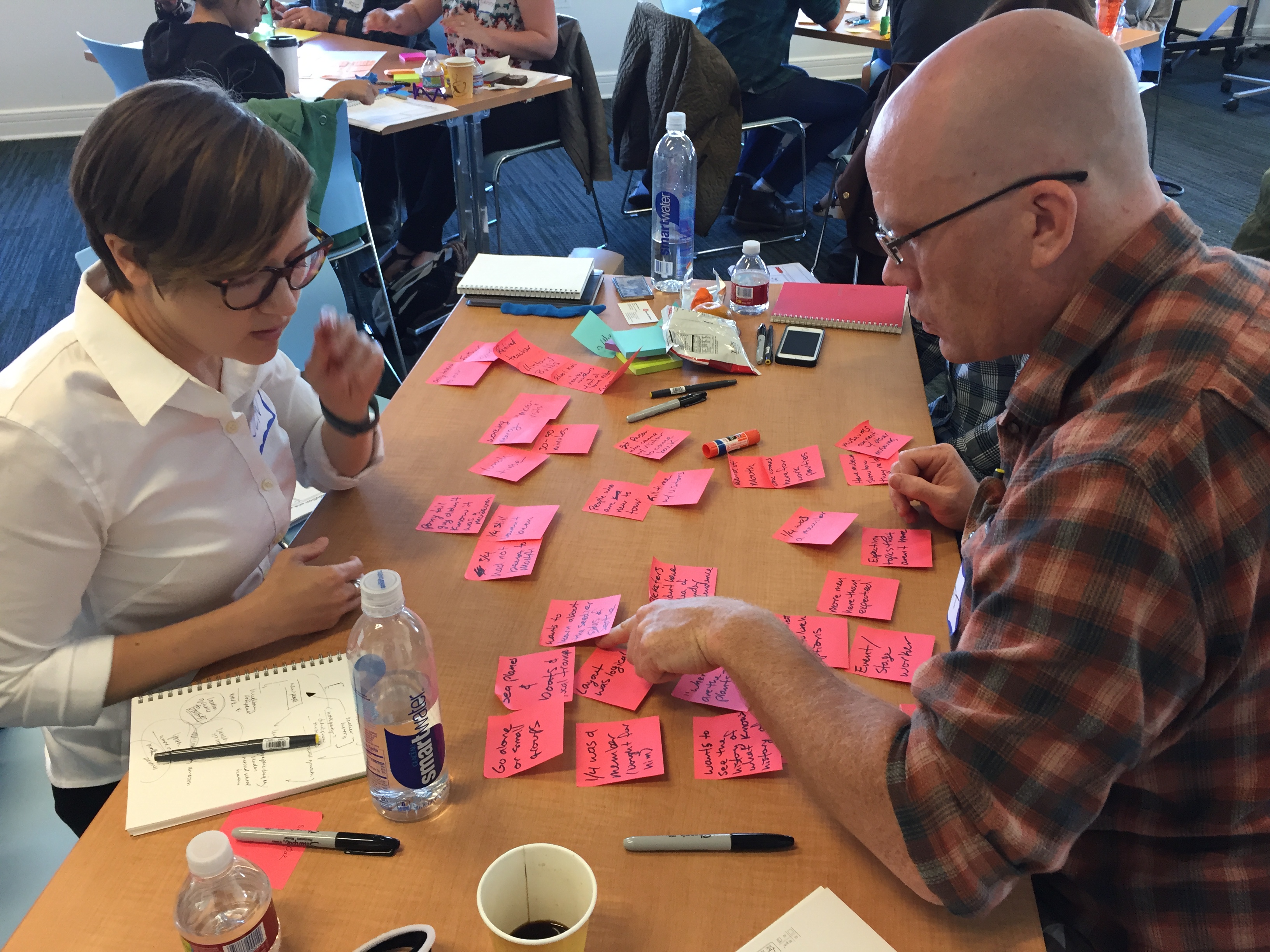 One of the more powerful tools that comes from Design Thinking is the idea of ‘reframing’ the way we look at the world to shed light on new opportunities. It is the process of reframing that yields products that stand out in the world like the Nest thermostat (not just a thermostat…a piece of art that helps you monitor and save energy) or Method soap (soap in a container beautiful enough you want to display it in your house).
One of the more powerful tools that comes from Design Thinking is the idea of ‘reframing’ the way we look at the world to shed light on new opportunities. It is the process of reframing that yields products that stand out in the world like the Nest thermostat (not just a thermostat…a piece of art that helps you monitor and save energy) or Method soap (soap in a container beautiful enough you want to display it in your house).
Looking at these products, we can imagine how the teams that created them must have been thinking about things in a different way. Somewhere along the way, they decided to solve a different problem than the one everyone else was trying to solve. How many years of minor improvements to thermostats had to happen before Nest came along and completely reinvented the thermostat? Too many.
So how did they get to this point? How did companies like Nest and Method find a different problem to solve?
It all comes from asking ‘Why’.
Surprisingly under-utiliized and quite simple, ‘why’ is an incredibly powerful tool. It is the key to discovering new opportunities by getting to the heart of what you are aiming for.
Take this simple example:
Let’s say you have you are in need of a cup of coffee. In most cases, solving that problem is straightforward…go to the kitchen or your nearby coffee shop and get a cup of coffee. Voila! Problem solved. Everything is beautiful.
But let’s say one day you wake up to find a horrible discovery…all the coffee beans in the US have been destroyed, all the coffee shops are closed, and you are all out of coffee in your kitchen. What is a person to do?!
Well, you could begin working hard to somehow obtain a cup of coffee. You could hold a bunch of meetings with your co-workers about how to address the shortage. You could try to build an internal campaign around ‘We need to get more coffee in here’ and see about staffing up and allocating resources toward coffee acquisition. You might even build a network of other organizations who need coffee and share knowledge around the best way to obtain it. All of this might get you closer to finding a few more cups of coffee in the world. You can pretty much bet that the challenge will be daunting given the major shortage. More importantly, every other organized group of coffee drinkers in the world who has encountered this problem is likely to be trying something similar. Ironically, this is what most companies do…they continue trying to solve the ‘cup-of-coffee’ problem.
Alternately, you could take a step back and see that your cup of coffee is really a means to an end. You could ask yourself, “What does this ‘cup of coffee’ solution really get me?” Perhaps the real reason for the cup of coffee is to take a break, stay awake, to create an opportunity to socialize with co-workers…or to to get warm or give you an excuse to take a walk. The more deeply you understand the ‘job’ that cup of coffee is doing, the more flexible you can be in solving your problem. You may discover that the best course of action in place of getting coffee is to invest in some chocolate and the creation of a nice walking trail to provide the perfect combination of respite and alertness.
As I’ve consulted and taught over the years, I’ve been surprised by how many organizations choose the former approach. They beat themselves up trying to solve the same difficult challenge over and over again. They choose to focus on the ‘cup of coffee’ problem when they could be focusing on alertness or respite or socialization. It is only when faced with a true crisis and forced to ask ‘why’ that they finally do. And often by then it is too late; competitors have discovered a new ‘why’ and organizational leaders find themselves playing catch up…a difficult place to survive.
So how to avoid this problem?
Well, the simplest way to stay ahead is to get in the habit of asking ‘why’ on a regular basis. Build it into your daily routine…Why are we really doing this? What is the ‘job’ this solution (whatever you are pursuing) is trying to do? Could it be that there is an easier way to achieve the same benefit? Might there be a new or recent creation/technology in the world that now allows things to be done differently?
Understanding the ‘why’ behind your product or service (often best discovered through deep customer research) can yield opportunities that set you ahead of the competition…opportunities that offer alternate paths for the organization or simply strengthen your existing brand offering.
Asking ‘why’ alone will only get you so far, however. The next level of asking ‘why’ is to ensure that you are doing this in a group. Group ‘why’ sessions are valuable for the same reason most design tools are valuable, they help you build agreement.
Quite often, organizations struggle to move forward because their leaders do not agree on the direction in which to head. This may happen explicitly, e.g. “Bob thinks we should pursue an app for millennials, but I’m convinced we need to beef up desktop support for baby boomers.”, but more often it exists quietly amidst the leaders without anyone calling it out.
In many cases employees are not aware they lack agreement. A leader may THINK everyone agrees, or perhaps because they have the power to do so, may move forward without asking for agreement and start building a new product. Then part-way through someone says something like “Wait…we’re building that? The real need is not X, it’s Y!”, at which point company leaders spend the next 6-8 weeks trying to convince each other of the direction they should now head. The ‘why’ conversation comes on the heels of time and resources wasted building the wrong product.
As an aside, this happens in politics all of the time. Our country currently has an agreement shortage. Perhaps a little bit of asking ‘why’ could help. I recently heard a woman exclaiming that we needed to repeal the Affordable Care Act (ACA) because ‘insurance premiums are too high’. Meanwhile, others are saying we need to keep the ACA for the very same reason. If somehow we could facilitate a group conversation around ‘why’ people want what they do, perhaps we could shift the conversation from ‘repeal or not repeal’ to ‘let’s all work on lowering premiums’. I’m optimistic.
So, in short, find opportunities to ask ‘why’. Do it in your head, do it out loud, do it with your customers, and do it with your colleagues. It will open up new opportunities to reframe the way you see the world, your life, and your business. It will help you build agreement among your colleagues, and it will focus the conversation on the issues that connect us and have the potential to make the world better for everyone.
I have brought many groups together to explore innovative opportunities by asking ‘why’, and every time I do, new ideas appear, excitement ensues, opportunities abound, and most importantly, the group builds agreement. They connect as a team and move their entire organization forward by asking the ‘silly’ questions no-one else was bold enough to ask.
Also, as you seek to create new things in the world, how might you find ways to remind yourself to ask ‘why’? How might you encourage others to do the same, to instigate potential re-frames and expose new opportunities? What opportunities might you create to ask ’why’ with your colleagues to build agreement?
